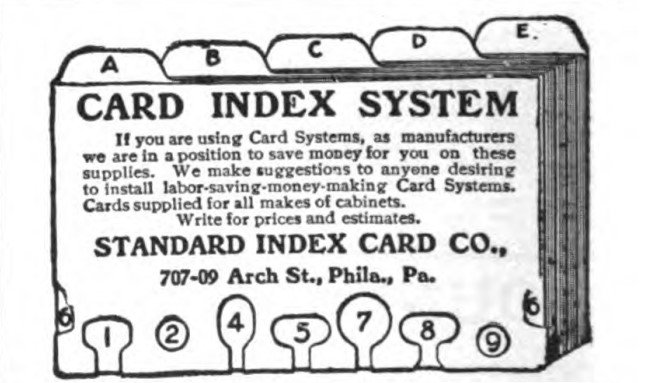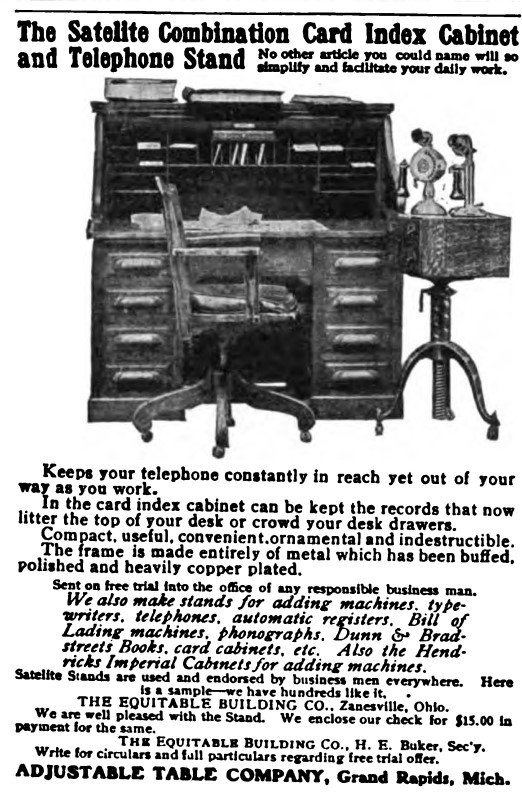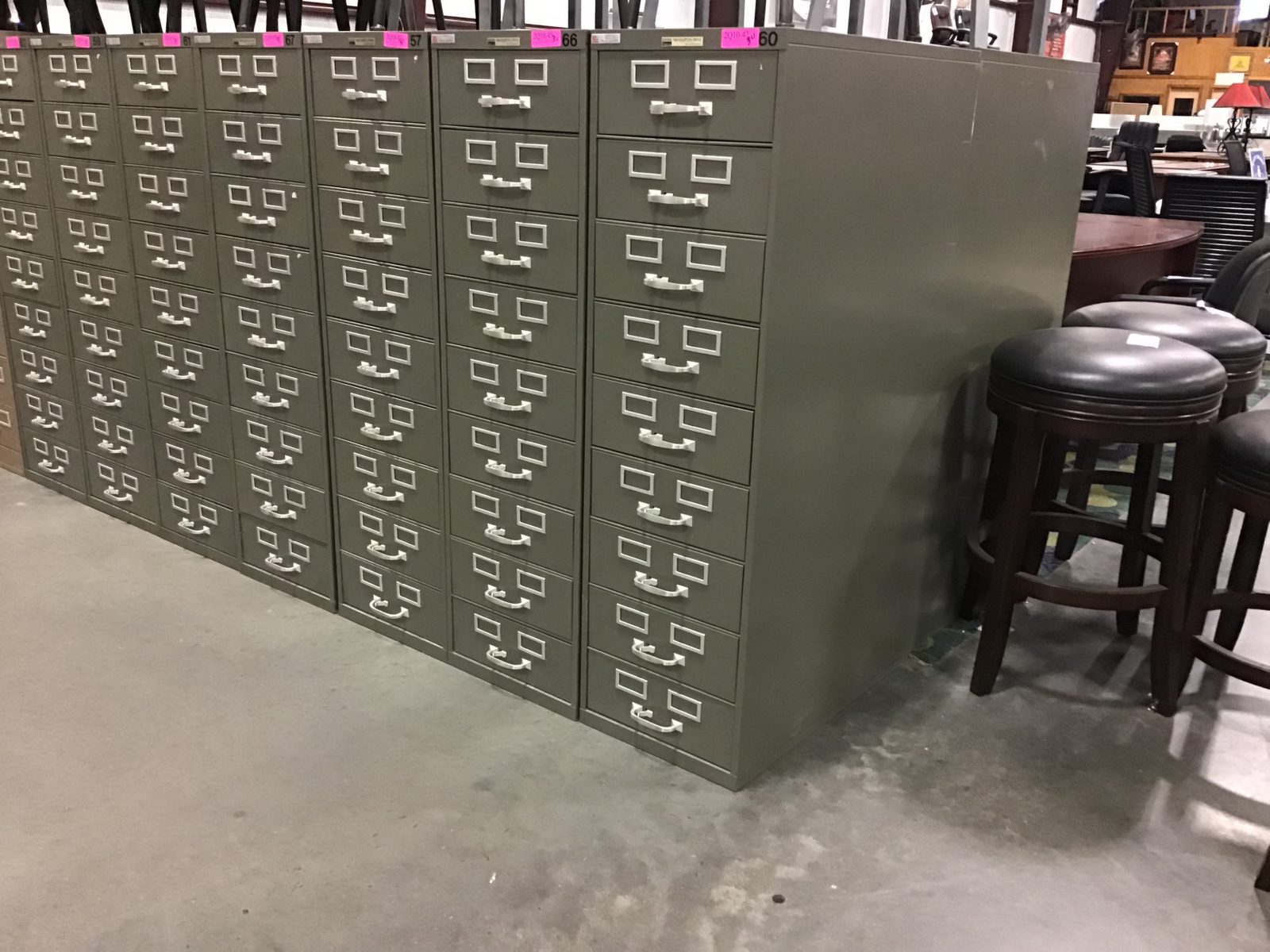https://www.metalcabinetliquidators.com/ Rancho Cucamonga, CA<br /> James
- Dec 2024
-
www.metalcabinetliquidators.com www.metalcabinetliquidators.com
-
orangecounty.craigslist.org orangecounty.craigslist.org
-
VISIT OUR HUGE OFFICE FURNITURE WAREHOUSE! Take a virtual tour here: https://youtu.be/0Ez-eB-0u8w (copy and paste) Recycled Office Furnishings 10036 Freeman Avenue Santa Fe Springs, Ca. 90670 We accept Visa, MC, Amex, and debit cards! Mon - Fri: 9am to 5pm, Sat: 9am to 2pm Please call for Saturday hours on holiday weekends www.recycledofficefurnishings.com *alternate phone number: 562 777-2289*
https://orangecounty.craigslist.org/fud/d/santa-fe-springs-index-filing-cabinet/7515311169.html
-
- Sep 2024
-
archive.org archive.org
-
Macey Filing Appliances 1906<br /> Catalogue No. 4206<br /> The Macey Co.<br /> https://archive.org/details/macey-filing-appliances-1906/mode/2up
-
- Jul 2024
-
www.reddit.com www.reddit.com
-
Does anyone here use a purpose made typewriter desk? How do you like it? Alternatively, has anyone tried one and found it wasn't for them?
I've used the small typewriter tables with drop sides and wheels before. I appreciate their small size and ability to move around. I'm actively looking for a new one at the moment. (I sold the original 20 years ago when downsizing during a move between apartments and prior to restarting my collection.)
I currently use a dual pedestal desk and and usually have my typewriters on the pull out writing drawers. This drops the typewriter an inch and makes one's typing position (27" off the floor) much more comfortable than having the typewriter higher up 29-31" for most modern desks and tables.
I have tested a pedestal desk with a spring-loaded typewriter platform that moves up and out of the desk after opening a door. This was an excellent experience, and if I find another, I will surely purchase it. The tough part is that they take up a lot of space as the internal desk space is given entirely to hiding the typewriter when not in use. They're definitely great if you have a heavy 30+ pound standard typewriter that's not so mobile.
The third type are wooden desks with two desk height levels. One for traditional desk work and a second lower one as the typewriter platform. The lower height is obviously much more ergonomic for typing for long periods. On most of these desks, the inset typewriter space is most often given completely over for the typewriter to be there permanently. If your plan is to only have a typewriter, then jump, but their use is more difficult if you're sharing that space with a computer and need to move the two back and forth regularly. Additionally, the wooden desks have either permanent cut outs or can be flipped over to hide the cutout and make the entire desk space flush when the typewriter isn't in use. You'll have to use your own gut to decide which of these two might be best for you. I recently saw a reasonable version of a convertible wooden desk at https://abqtypers.substack.com/p/convertible-typewriter-desk
I find these pop up pretty regularly in the $200-500 range. Often owners don't want them because they don't use typewriters, and they don't move easily, so they're likely to come down in price pretty quickly/easily.
-
- Apr 2024
-
-
“Business Machines.” The Journal of Business Education, September 1, 1930. https://www.tandfonline.com/doi/abs/10.1080/00219444.1930.10771593.
-
- Jan 2024
-
Local file Local file
-
The Charging This consists in its interior arrangement ofCabinet rows of pigeon-holes constructed on an inclineupwards so that the base of each horizontalrow of pigeon-holes is higher than its predecessor. Into thesepigeon-holes the charging shps are placed and there is a guidecard to each pigeon-hole marking the divisions of the charging slipsby giving the number of the slip which is to be filed immediatelybehind it.
While slightly different in its physical configuration, the office charging cabinet (with a bleacher-like set up) is very similar to the similarly named library card charging tray.
Which came first?
-
-
-
FireKing File Cabinet, 1-Hour Fire Protection, 6-Drawer, Small Document Size, 31" Deep<br /> https://www.filing.com/FireKing-Card-Check-Note-Cabinet-6-Drawer-p/6-2552-c.htm
A modern index card catalog filing solution with locks and fireproofing offered by FireKing for $6,218.00 with shipment in 2-4 weeks. 6 Drawers with three sections each. Weighs 860 lbs.
at 0.0072" per average card, with filing space of 25 15/16" per section with 18 sections, this should hold 64,843 index cards.
-
- Dec 2023
-
www.ebay.com www.ebay.com
-
In 1895 they changed their name to the Office Specialty Manufacturing Company.
This is a horrible source for this fact as I'm reasonably sure they had Y&E well after 1895, but check this out. Did they maybe split off part of the company?
-
-
industrialartifacts.net industrialartifacts.net
-
https://industrialartifacts.net/
Some nice vintage furniture and miscellaneous hardware.
-
- Nov 2023
- Sep 2023
-
babel.hathitrust.org babel.hathitrust.org
-
https://babel.hathitrust.org/cgi/pt?id=mdp.39015071458213&seq=1
Modern Filing Systems<br /> Wagemaker Furniture Company, Ltd. 1904 furniture catalog
-
- Aug 2023
-
www.hoppersofficefurniture.com www.hoppersofficefurniture.com
-
Has carried used metal card index files in the past for $295
-
-
www.reddit.com www.reddit.com
-
Why is the index card half full?
reply to u/ManuelRodriguez331 at https://www.reddit.com/r/Zettelkasten/comments/15ehcy5/why_is_the_index_card_half_full/
There has been debate about the length of notes on slips since the invention of slips and it shows no signs of coming to broad consensus other than everyone will have their personal opinion.
If you feel that A6 is is too big then go down a step in size to A7. One of the benefits of the DIN A standard is that you can take the next larger card size and fold it exactly in half to have the next size smaller. This makes it easier to scale up the size of your cards if you prefer most of them to be smaller to save space, just take care not to allow larger folded cards to "taco" smaller cards in a way they're likely to get lost. If you really needed more space, you could easily use an A1 or A2 and fold it down to fit inside of your collection! (Sadly 4x6 and 3x5 cards don't have this affordance.)
Fortunately there are a variety of available sizes, so you can choose what works best for yourself. Historically some chose large 5x8", 6x9", or even larger "slips". Some have also used different sizes for different functions. For example some use 3x5 for bibliographic cards and 4x6 for day-to-day ideas. I've seen stacked wooden card catalog furniture that had space for 3x5, 4x6, and 8.5x11 in separate drawers within the same cabinet. Some manufacturers even made their furniture modular to make this sort of mixed use even easier.
One of the broadly used pieces of advice that does go back centuries is to use "cards of the same size" (within a particular use case). This consensus is arrived at to help users from losing smaller cards between larger/taller cards. Cards of varying sizes, even small ones, are also much more difficult to sort through. Slight of hand magicians will be aware of the fact that shaving small fractions of length off of playing cards is an easy way of not only marking them, but of executing a variety of clever shuffling illusions as well as finding some of them very quickly by feel behind the back. Analog zettelkasten users will only discover that smaller, shorter cards are nearly guaranteed to become lost among the taller cards. It's for this reason that I would never recommend one to mix 4x6, A6, or even the very closely cut Exacompta Bristol cards, which are neither 4x6 nor A6!
I once took digital notes and printed them on paper and then cut them up to fit the size of the individual notes to save on space and paper. I can report that doing this was a painfully miserable experience and positively would NOT recommend doing this for smaller projects much less lifelong ones. Perhaps this could be the sort of chaos someone out there might actually manage to thrive within, but I suspect it would be a very rare individual.
As for digital spacing, you may win out a bit here for "saving" paper space, but you're also still spending on storage costs in electronic formatting which historically doesn't have the longevity of physical formats. Digital also doesn't offer the ease of use of laying cards out on a desktop and very quickly reordering them for subsequent uses.
There are always tradeoffs, one just need be aware of them to guide choices for either how they want to work or how they might work best.
Personally, I use 4x6" cards because I often write longer paragraphs on them. Through experimentation I found that I would end up using two or more 3x5 cards more often than I would have had mostly blank 4x6 cards and used that to help drive my choice. I also find myself revisiting old cards and adding to them (short follow ups, links to other cards, or other metadata) and 3x5 wouldn't allow that as easily.
As ever, YMMV...
See also: [[note lengths]] and/or [[note size]].
-
- May 2023
-
www.ebay.com www.ebay.com
- Mar 2023
-
www.ebay.com www.ebay.com
-
Antique Typewriter Cole Steel Made In West Germany 1960s Vintage w/ orig. case
Apparently Cole Steel manufactured typewriters in the 1960s.
-
-
-
Wigent, William David, Burton David William Housel, and Edward Harry Gilman. Modern Filing and How to File: A Textbook on Office System. Rochester, N.Y.: Yawman & Erbe Mfg. Co., 1916. http://archive.org/details/modernfilingate02compgoog.
Original .pdf converted with docdrop.org for OCR annotation on 2023-03-24.
annotation target: urn:x-pdf:3c1f14d64c91cf4b513efa16df4ed90d
Annotations: https://hypothes.is/users/chrisaldrich?q=url%3Aurn%3Ax-pdf%3A3c1f14d64c91cf4b513efa16df4ed90d
-
-
www.facebook.com www.facebook.com
-
Muskegon Heritage Museum of Business and Industry · rsdoSptneoiy4 720fhi2tg41m80ga8Ju2542l, 71510glu065h1t196m9t · Shared with PublicBrowne-Morse CompanyIn 1907, former Shaw Walker executive Frank Morse partnered with retired plumbing dealer Richard Browne to start a new office equipment manufacturing company. They began in a small factory on Barney Street in Muskegon Heights. Browne-Morse quickly expanded over the next couple of years, relocating to the former Grand Rapids Desk Co building on Broadway. They would remain there for the next 70 years. The image shows the factory as it looked in 1911.
Attached image of the factory has a sign across two sides of the building that repeats the words: "Quality Cabinets Browne-Morse Company"
Frank Morse, a former Shaw-Walker executive, partnered with retired plumbing dealer Richard Browne in 1907 to form the Browne-Morse Company which would manufacture office equipment.
-
-
archive.org archive.org
-
Shaw-Walker. Flexowriter File-Desks. Accessed March 24, 2023. http://archive.org/details/TNM_Flexowriter_File-Desks_-_Shaw-Walker_20171021_0001.
An interesting in-desk filing system for punched cards. Interesting I've not seen anything like this prior for a mini card index maintained in an office desk drawer.
Perhaps such a system wouldn't have been as easily accessible for use on a daily basis versus potentially more portable small systems that could have been transferred from desk to desk (person to person).
-
-
archive.org archive.org
-
How to Run a War Chest Campaign. Rochester, N.Y.: Yawman & Erbe Mfg. Co., 1918. http://archive.org/details/howtorunwarchest00yawm.
Broadly a manual on how to do a big community fundraising effort. Emphasis on furniture and filing systems that could be purchased from the publisher of the piece.
-
-
www.ebay.com www.ebay.com
-
https://www.ebay.com/itm/155447667554
This Catalog has a page with the various sizes of card catalog boxes available from Cole Steel in 1950s. The external sizes can be useful for placing the individual card sizes for some of these boxes on the secondary market.
They also include approximate card capacities.

-
-
-
STANDARD INDEX CARD CO.
Fascinating to see the 8 various types of hole punches different card index systems may have used on their index card filing cabinets.
Advertisement from System, December 1906:

CARD INDEX SYSTEM <br /> If you are using Card Systems, as manufacturers we are in a position to save money for you on these supplies. We make suggestions to anyone desiring to install labor-saving-money- making Card Systems.<br /> Cards supplied for all makes of cabinets.<br /> Write for prices and estimates.<br /> STANDARD INDEX CARD CO.,<br /> 707-09 Arch St., Phila., Pa.
-
OurNew "400"SeriesNo.400(likecut)hasdeepdrawerarrangedwithVERTICALFILINGEQUIPMENT,writingbednotbrokenbytypewriter,whichdisappearsindust-proofcompartment.GUNNDESKSaremadein250differentpatterns,inallwoodsandfinishes,fittedwith ourtimesavingDROP-FRONTPigeonholebox.Ifyoudesireanup-to-datedeskofanydescriptionandbestpossiblevalueforyourmoneygetaGunn.Ourreference-TheUser-TheManwiththeGunn."Soldbyallleadingdealersorshippeddirectfrom thefactory.Sendforcatalogueof desksandfilingdevices-mailedFREE."AwardedGoldMedal,World'sFair,St.Louis."GUNNFURNITURECO.,GrandRapids,Mich.MakersofGunnSec-tionalBookCases
Gunn Desks and filing cabinets
Example advertisement of a wooden office desk with pigeonholes and a small card index box on the desktop as well as a drawer pull with a typewriter sitting on it.
-
Federal Steel FixtureCompany
Federal Steel Fixture Company manufactured a variety of steel office furniture including desks, cabinets, lockers, filing cabinets, shelving, and card cabinets.
-
TheSateliteCombinationCard IndexCabinetandTelephoneStand

A fascinating combination of office furniture types in 1906!
The Adjustable Table Company of Grand Rapids, Michigan manufactured a combination table for both telephones and index cards. It was designed as an accessory to be stood next to one's desk to accommodate a telephone at the beginning of the telephone era and also served as storage for one's card index.
Given the broad business-based use of the card index at the time and the newness of the telephone, this piece of furniture likely was not designed as an early proto-rolodex, though it certainly could have been (and very well may have likely been) used as such in practice.
I totally want one of these as a side table for my couch/reading chair for both storing index cards and as a temporary writing surface while reading!
This could also be an early precursor to Twitter!
Folks have certainly mentioned other incarnations: - annotations in books (person to self), - postcards (person to person), - the telegraph (person to person and possibly to others by personal communication or newspaper distribution)
but this is the first version of short note user interface for both creation, storage, and distribution by means of electrical transmission (via telephone) with a bigger network (still person to person, but with potential for easy/cheap distribution to more than a single person)
-
THE BERGER MFG. CO. ,
NoHarm Done Fire and Water may play havoc with your office yet your business need suffer either loss nor delay if you will safeguard your valuable documents and business records by the use of BERGER STEEL OFFICE FURNITURE AND SECTIONAL FILING DEVICES fireproof, water-tight and absolutely indestructible. Unlike the insurance company we do not guarantee to replace your loss-we preserve you from loss. We will send free on request our illustrated book " Steelsects" completely describing our handsome line of steel fire- proof Desks, Tables, Wardrobes, Filing Cabinets, Vault Equipments. Webuild special steel office equipment to order. Write us your requirements and we will furnish estimates. THE BERGER MFG. CO. , Canton, Ohio Specialties: Metal Ceilings, Roofing, Siding New York, Boston, Philadelphia, St. Louis. and Fire- proof Construction ...
-
The Metal Sectional Furniture Company9 Willow Drive,Benton Harbor,Michigan
The Metal Sectional Furniture Company was manufacturing steel filing cabinets in 1906 in Benton Harbor Michigan.
Tags
- Berger Manufacturing Co.
- Metal Sectional Furniture Company
- postcards
- telephones
- Philadelphia Pennsylvania
- user interface
- zettelkasten boxes
- office furniture
- 1906
- audience
- technology
- card index for business
- telegraph
- rolodexes
- evolution of technology
- desktop applications
- intellectual history
- Canton Ohio
- card index
- annotations
- advertising
- Benton Harbor Michigan
- Federal Steel Fixture Company
- card index filing cabinets
- satelite stands
- filing cabinets
- Gunn Furniture Co.
- Grand Rapids Michigan
- Adjustable Table Company
- Standard Index Card Co.
Annotators
-
-
boffosocko.com boffosocko.com
-
The width of the drawers of both McDowell & Craig and Steelcase desks is just wide enough to accommodate two rows of 4 x 6" index cards side by side with enough space that one might insert a sizeable, but thin divider between them
I suspect that this is a specific design choice in a world in which card indexes often featured in the office environment of the mid-twenty first century.
Were other manufacturers so inclined to do this? Is there any evidence that this was by design? Did people use it for this? Was there a standard drawer width?
The metal inserts to section off the desk drawer area could have also been used for this sort of purpose and had cut outs to allow for expanding and contracting the interior space.
Keep in mind that some of these tanker desks were also manufactured with specific spaces or areas intended for typewriters or for storing them.
-
- Nov 2022
-
www.bisley.sk www.bisley.sk
-
www.vaultz.com www.vaultz.com
-
https://www.vaultz.com/vaultz-vz01395-black-locking-4x6-index-card-cabinet-double-drawer
These are the type used by various people including Scott P. Scheper.
-
-
americanhistory.si.edu americanhistory.si.edu
-
Trade catalogs from Yawman and Erbe Mfg. Co.
https://americanhistory.si.edu/collections/search/object/SILNMAHTL_34484
-
-
www.newmarkettoday.ca www.newmarkettoday.ca
- Aug 2022
-
www.reddit.com www.reddit.com
-
Card Storage
reply on: https://www.reddit.com/r/antinet/comments/wzblc9/card_storage/
The smaller 1 to 3 drawer vintage metal card files are readily available on eBay usually between $15 and $40. This isn't bad given how expensive new files can run. Many were made with small fittings that allow them to be stackable. Usually these are sturdy, but light enough for relatively inexpensive shipping.
The larger multi drawer full cabinets can run a couple hundred, but their bigger issue is that they're so large and heavy that they can be in the range of $800 or more to ship anywhere. If you want something like this, your best bet is to try to find something local that you can drive to and pick up locally. If you're into 4x6" cards, double check with the seller to make sure that they'll fit. Often even the somewhat larger cabinets are a 1/4" too short for 4x6 cards, much less the slightly taller tabbed cards (A-Z) you might use for separating sections. I've refinished some old steel furniture like this in the past and it's not easy or cheap, but if someone is desperate...
https://www.ebay.com/b/Index-Card-File-Cabinet-In-Office-Filing-Cabinets/3299/bn_7022123911
Those who might want something new might also look into Bisley which makes some reasonably nice card index files with and without locks, though you might have to order them directly through their New York Offices. https://www.bisley.sk/userfiles/bisley/product/e84b22bf2d7156d048ad076ff74f895d.pdf
-
-
-
shall I adopt the 3x5 slip or the 4x61
Dow indicates in 1924 that 3 x 5" and 4 x 6" are both commonly had in a range of materials the US as well as boxes or cases to keep them in. He does mention that one can also cut their own paper, indicating that this is a possibility.
Tags
Annotators
-
-
scholar.lib.vt.edu scholar.lib.vt.edu
-
www.washingtonpost.com www.washingtonpost.com
-
www.reddit.com www.reddit.com
-
I have a notifications on the German equivalent to craigslist on Karteikasten, Karteikartenschrank, Karteischrank, Apothekenschrank and the like in a 50km radius around here. Hope one day something comes up that is reasonable priced and small enough to fit the trunk of our little electric car :-)
https://www.reddit.com/r/antinet/comments/wjvoqq/if_youre_going_to_cast_some_zettels_you_may_as/
A list of German words and English equivalents for index card related containers and furniture
Karteikasten - index box<br /> Karteikartenschrank - index card cabinet<br /> Karteischrank - filing cabinet Apothekenschrank - apothecary cabinet
-
-
www.officebarn.biz www.officebarn.biz
-
9 drawer card catalog file<br /> Remington Rand

-
-
www.officebarn.biz www.officebarn.biz
-
8 drawer card catalog file<br /> Allsteel

-
-
-
Alternate index card holding furniture for display?<br /> https://www.reddit.com/r/antinet/comments/wffvs4/alternate_index_card_holding_furniture_for_display/
Separate from boxes for long term card holding storage, does anyone have any suggestions they like for organizing or temporarily displaying cards?
I've got a couple card tray rack organizers (originally intended for playing cards, but great for zettels) which I generally like.

I've also seen Levenger's note card "bleachers" which are similar, but more expensive. - Note Card Bleachers - Portable Note Card Bleachers - Nantucket Bamboo Compact Bleachers
 Levenger index card bleacher for compactly displaying index cards in an array on a desk so that portions are visible but that they don't take up space.
Levenger index card bleacher for compactly displaying index cards in an array on a desk so that portions are visible but that they don't take up space.Does anyone have anything else they like for compact working/displaying aside from laying cards out on tables/desks?
Do you have other methods for this sort of organization or layout of ideas visually? Corkboards, magnetic whiteboards/walls, other?
-
